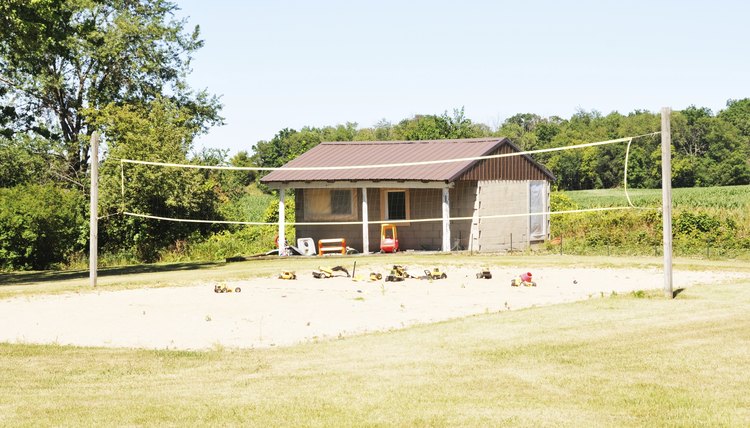How Big Is a Volleyball Court in Feet?

The length of a volleyball court depends largely on the number of players participating. A beach volleyball doubles match, for instance, will have a smaller court than a standard match involving six players on each side. Matches set up by USA Volleyball, the NCAA and other official volleyball leagues will have small, likely unnoticeable differences in dimensions compared with a recreational volleyball court, which is used more for intramural and less-competitive matches.
General Court Dimensions
A recreational volleyball court is 60 feet in length and 30 feet wide. If you are interested in building a court or roping off an area to play volleyball, these are the dimensions to use and are the same as will be found in the majority of gyms. Indoor courts sanctioned by the International Volleyball Federation, USA Volleyball and the NCAA are slightly smaller, measuring 59 feet long and 29 feet 6 inches wide. This is for a match with six players on each side of the net.
AVP and Olympic Dimensions
The Association of Volleyball Professionals (AVP) and the Olympics feature doubles beach volleyball, consisting of two players on each side of the net. Since there are fewer players on the court, the dimensions are smaller: A doubles beach volleyball court is 52 feet 6 inches long and 26 feet 3 inches wide.
Overhead Clearance
The NCAA recommends that the space above an indoor court be 41 feet, which is measured from the playing surface. The rules also state that the playing space above the court must be free of any obstruction to a minimum of 25 feet for facilities that were built after 2006.
Center and Attack Lines
A net divides the court in half lengthwise along a center line, making for square areas on either side of the net. Each side of a recreational court will be 30 feet square, each side of a sanctioned court will be 29 1/2 feet square, and each side of a doubles sand court will be 26 1/4 feet square. An attack line is marked off 10 feet back from the center line on each side of indoor courts to mark the point behind which players may attack the ball. Sand courts do not have this line or a center line since attacks may begin from anywhere and players may cross under the net in some circumstances.
Free Zone
The free zone is the area around the court in which players can enter to play the volleyball, but only after the ball is served. On standard courts, the outer area is a minimum of 10 feet wide on every side, but can be undefined, as natural barriers can end the free zone. In beach volleyball, the free zone is a defined area, between 16.4 and 19.7 feet wide
Resources
Writer Bio
Kyle Odegard began his journalism career in 2003 and is currently a professional sports writer in Arizona. He has written for the "Seattle Times," the "San Jose Mercury News," the "Las Vegas Review-Journal," MLB.com, Bookmaker.com, the "Associated Press" and others. He holds a Bachelor of Arts in journalism and mass communication from Arizona State University.
